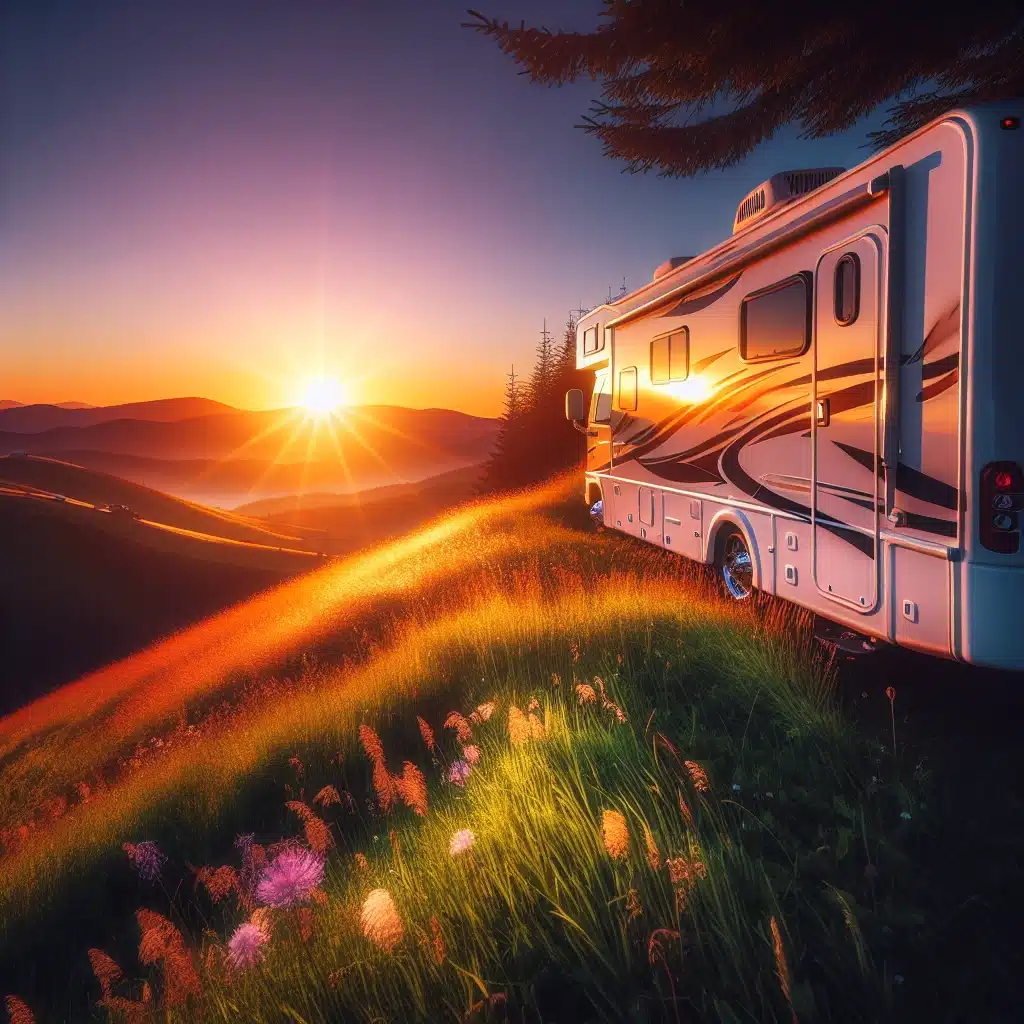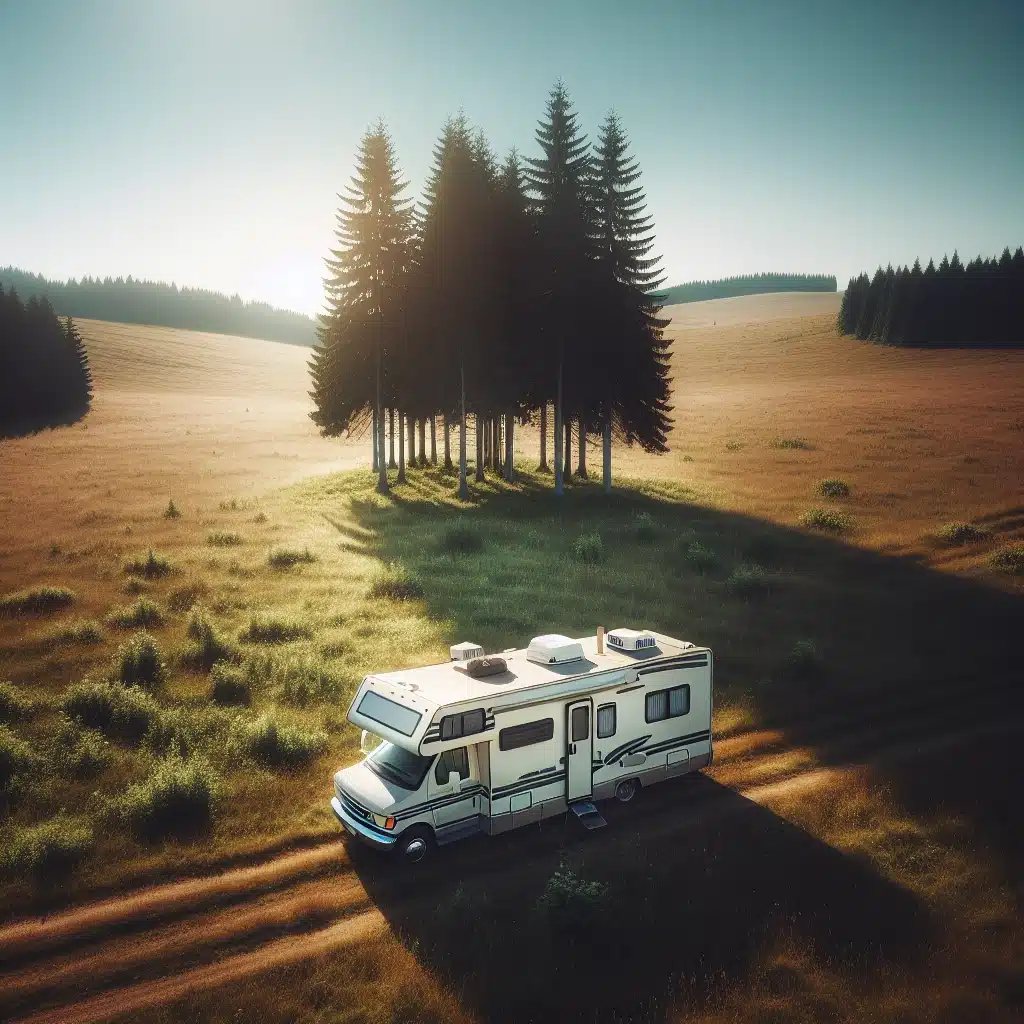Table of Contents

Off-Grid Power Mastery for Boondockers
Imagine the freedom of exploring without the tether of a power hookup. That’s what boondocking is all about. But to do it right, you need a solid plan for powering your RV. Let’s get your rig set up with the best off-grid power solutions, so you can enjoy the wilderness without sacrificing comfort.
Top Solar Solutions to Keep Your RV Powered
When it comes to keeping your lights on and your fridge cold, solar power is the king of the off-grid world. It’s clean, quiet, and once you’ve made the initial investment, the energy is completely free. There are a few solar solutions that stand out for their efficiency and reliability. Let’s explore the options that will keep your adventures powered day and night.
- Solar Panels: The heart of any solar setup, these come in various sizes to fit the roof of your RV.
- Charge Controllers: These protect your batteries from overcharging and help maximize their lifespan.
- Battery Banks: Where you’ll store the energy collected by your panels for use anytime.
- Inverters: Convert the stored DC power into AC power so you can use it with your standard appliances.
- Portable Solar Kits: Perfect for those who prefer a plug-and-play solution or need a portable option.
Understanding Your RV’s Power Needs
Before diving into solar, it’s crucial to understand your power needs. Start by making a list of all the appliances you use and note their wattage. This will help you determine the size of the solar system required to keep everything running smoothly.
Remember, not all appliances are created equal. Some, like air conditioners and microwaves, are energy hogs, while others, like LED lights, sip power gently. Knowing where your power goes is the first step to efficient off-grid living.
Must-Have Energy-Efficient Appliances
When you’re off the grid, every watt counts. That’s why energy-efficient appliances are a must. They use less power, which means you can get by with a smaller solar setup and fewer batteries. Here are some must-haves for your energy-saving arsenal:
- LED Lighting: They use a fraction of the power of traditional bulbs.
- 12V Appliances: Designed for RV use, they’re more efficient than their household counterparts.
- Energy Star Fridges: These use less power and are better insulated to keep the cold in.
- Low-Flow Showerheads: Save water and the energy to heat it.
- Solar Ovens: Cook your meals using nothing but the sun’s rays.
The Sun is Your Fuel: Best Solar Panels for RVs
Solar panels are the engines of your off-grid power system. But not all panels are created equal. The two main types you’ll encounter are monocrystalline and polycrystalline, each with its own advantages. Your choice will depend on factors like space, budget, and power needs.
Monocrystalline vs. Polycrystalline: What’s Right for You?
Monocrystalline panels are the go-to for many RVers. They’re more efficient, which means they can generate more power in a smaller space. But they do come with a higher price tag. Polycrystalline panels, on the other hand, are more affordable but also less efficient. If you have the space for a larger setup, they might be the right choice for you.
Let’s break it down:
- Monocrystalline: Higher efficiency, smaller size, but more expensive.
- Polycrystalline: Lower efficiency, larger size, but cost-effective.
Choosing the right solar panels is a balance between what you need and what you can afford. Consider how much space you have available for panels and how much power you need to generate. Your adventures don’t have to be limited by your budget or your roof size.
Mounting Solar Panels: Tips and Tricks
Mounting your solar panels is more than just securing them to your RV roof. It’s about finding the sweet spot where they’ll get maximum sunlight while being protected from the elements. Use mounting brackets that allow for air flow beneath the panels to keep them cool and efficient. Ensure they’re tilted towards the sun and avoid shade from trees and other structures as much as possible.
Maximizing Sun Exposure: Panel Angles and Placement
The angle of your solar panels can significantly impact their efficiency. In general, you want to angle them so they’re perpendicular to the sun’s rays. This might mean adjusting the tilt seasonally or even daily if you’re stationary for a while. Placement is key too—keep panels clear from shadows cast by AC units, satellite dishes, or vent pipes.

Storing Sunshine: Choosing the Right Batteries
Your solar panels are only as good as the batteries that store their power. The right batteries can mean the difference between a fridge full of fresh food and a premature end to your off-grid adventure. Deep cycle batteries are designed for the regular charging and discharging that solar systems require.
AGM vs. Lithium: Pros and Cons
AGM (Absorbent Glass Mat) batteries are a popular choice for their maintenance-free nature and lower upfront cost. However, they’re heavier and have a shorter lifespan than their lithium counterparts. Lithium batteries, while more expensive, offer a longer lifespan, faster charging, and are much lighter, which can be a real bonus in an RV.
- AGM Batteries: More affordable, maintenance-free, but heavier and shorter lifespan.
- Lithium Batteries: Lightweight, longer lifespan, but with a higher upfront cost.
Sizing Your Battery Bank for Extended Trips
When planning for extended off-grid trips, the size of your battery bank is crucial. You want enough capacity to store the energy you’ll generate during the day. A good rule of thumb is to have enough battery capacity to cover your energy use for at least two to three days without sun. This gives you a buffer for those cloudy days. For more details on selecting the right battery for your needs, see our RV Solar Battery Buying Guide.
Maintaining Battery Health While Off-Grid
Maintaining your battery health is all about balance. Don’t let your batteries discharge too deeply on a regular basis—aim to keep them above 50% capacity. Regularly monitor your battery levels and charge them fully whenever possible. This helps prevent sulfation and extends the life of your batteries, ensuring they’ll keep you powered up for many adventures to come.
Converting Power Efficiently: Inverters Explained
So you’ve harnessed the sun’s power, and your batteries are charged. Great! But there’s a catch. Your solar panels and batteries store energy as direct current (DC), while most of your RV appliances need alternating current (AC) to work. That’s where inverters come in. They convert DC power from your batteries into AC power for your appliances. It’s like translating a language so everyone can understand each other.
Pure Sine Wave vs. Modified: What Does Your RV Need?
There are two main types of inverters: pure sine wave and modified sine wave. Pure sine wave inverters are the gold standard. They provide clean power that’s identical to what you get from a household outlet, making them perfect for sensitive electronics like laptops and TVs. Modified sine wave inverters are less expensive but can cause issues with some appliances and aren’t as efficient.
- Pure Sine Wave: Ideal for sensitive electronics, mimics household power.
- Modified Sine Wave: More affordable, but not compatible with all devices.
Think about what you’ll be powering. If you can’t live without your gadgets, a pure sine wave inverter is the way to go. But if you’re just powering simple tools or appliances, a modified sine wave might do the trick and save you some cash.
Calculating Your Inverter Size: A Step-by-Step Guide
Getting the right size inverter is like choosing shoes. Too small, and it won’t work. Too big, and you’ve wasted money. Here’s how to find the perfect fit:
- List all the appliances you’ll use at the same time.
- Add up their wattages (check the labels or manuals).
- Factor in a little extra, because starting an appliance can take more power than running it.
- Choose an inverter with a wattage rating above your total.
For example, if your combined appliances use 1000 watts, look for an inverter rated at least 1200 watts. This gives you a buffer to avoid overloading the inverter.

Supplemental Power Options
Solar is fantastic, but what about those days when the sun plays hide and seek? Or when you need a little extra juice? That’s when supplemental power options come into play. They can save the day (or night) and keep you comfortable no matter what Mother Nature throws at you.
Using a Portable Generator as a Backup
Generators are the classic backup power source. They’re reliable and can power anything from your lights to your air conditioner. But remember, they can be noisy and require fuel. If you’re going to use one, choose a model designed for RV use, which will be quieter and more fuel-efficient.
- Keep it topped up with fuel and ready to go.
- Run it regularly to keep it in good working order.
- Always use it outdoors to avoid dangerous exhaust fumes.
Think of your generator like a spare tire. You hope you won’t need it, but you’ll be glad it’s there if you do.
Wind Power on the Road: Feasibility and Installation
Wind power isn’t as common as solar, but it’s an option for those who want to harness another element of nature. Small wind turbines can be mounted on your RV to generate power as you travel or when you’re parked in a breezy spot. They work best in open areas where wind is consistent and strong.
- Research local wind conditions to ensure it’s a viable option.
- Choose a turbine designed for RV use—compact and easy to mount.
- Consider a hybrid system with both solar and wind for maximum coverage.
Wind power can be a great complement to solar, filling in the gaps on cloudy or stormy days. Just be sure to check with campgrounds, as some may have restrictions on structures like wind turbines.
Real-World Solar Setup Examples
There’s no better way to understand the impact of solar power on boondocking than through real-world examples. From small rigs to family-sized setups, solar power is transforming the RV experience. Let’s take a look at how two different setups meet the unique needs of their owners.
Case Study: Small Rig Solar Setup
Meet Jake, an avid solo traveler with a small, nimble RV. He wanted to extend his stays in the wild without relying on noisy generators or crowded RV parks. Jake installed a modest solar system consisting of two 100-watt monocrystalline panels, a 30-amp charge controller, and a pair of 100Ah AGM batteries.
His energy-efficient appliances, including LED lighting and a 12V fridge, ensure his power needs are met. Jake’s setup allows him to stay off-grid for up to a week at a time, with his laptop and camera gear always charged and ready for his travel blogging.
Case Study: Full-Time Family Living Solar Usage
Sarah and Tom, along with their two kids, live full-time in their RV. They required a robust system to support their homeschooling needs and home-based business. They opted for a larger setup with six 200-watt monocrystalline panels, a 60-amp MPPT charge controller, and a 400Ah lithium battery bank.
Their inverter is a 3000-watt pure sine wave model, ensuring they can run their air conditioner, microwave, and other high-draw appliances. This setup not only provides them with the power they need but also the freedom to boondock in some of the most scenic locations across the country.
Article-at-a-Glance: Key Takeaways
As we’ve explored the realm of RV solar power, here are the key takeaways to remember:
- Solar power is a silent, sustainable solution for off-grid RV living.
- Understanding your power needs is crucial for designing an efficient solar system.
- Energy-efficient appliances can significantly reduce your power consumption.
- Choosing the right type of solar panel, battery, and inverter is essential for a reliable setup.
- Real-world examples show that solar power is versatile and can be tailored to different RV lifestyles.
Maintaining an Eco-Friendly Boondocking Lifestyle
Embracing solar power is a significant step towards an eco-friendly boondocking lifestyle. It’s about more than just energy independence—it’s a commitment to preserving the natural beauty that we, as RV enthusiasts, love so much. By choosing renewable energy, we reduce our carbon footprint and set an example for others to follow.
Frequently Asked Questions (FAQ)
Got questions? You’re not alone. Here are some of the most common queries we get about RV solar power and boondocking:
How Long Can My RV Stay Powered with Solar Panels?
The length of time your RV can stay powered solely by solar panels is influenced by several factors: the size of your solar array, the capacity of your battery bank, your energy usage, and the availability of sunlight. If you’re conservative with your power consumption and have a well-sized system, you could potentially keep your RV powered indefinitely. It’s all about balancing the power you generate with the power you use.
What is the Cost of a Full RV Solar Setup?
Investing in a solar setup for your RV can range from a few hundred dollars for a basic kit to several thousand for a comprehensive system. A typical setup with a couple of hundred watts of solar panels, a charge controller, batteries, and an inverter might cost between $2,000 and $4,000. Remember, while the upfront cost can be significant, the long-term savings on campground fees and generator fuel can make solar power a financially sound choice.
Can I Install RV Solar Panels Myself?
Yes, with some research and basic DIY skills, you can install solar panels on your RV. Many solar kits come with instructions designed for self-installation. However, if you’re not comfortable with electrical work or if your setup is particularly complex, it’s wise to enlist the help of a professional. Safety and efficiency are paramount when working with electrical systems.
How Do I Monitor My Solar Power Usage?
Monitoring your solar power usage is key to managing your off-grid energy system. There are several tools available, from basic battery monitors to sophisticated systems with smartphone connectivity. These systems can track your power generation, usage, and battery status, giving you a clear picture of your energy profile and helping you make adjustments to avoid running out of power.
Are Portable Solar Panels Effective for RV Boondocking?
Portable solar panels are a fantastic option for boondockers. They offer flexibility, allowing you to park in the shade while placing your panels in the sun. While they may not provide as much power as a fixed system, they can certainly meet the needs of those with modest power requirements or serve as a supplementary power source.
As we wrap up, remember that the world of RV solar power is evolving rapidly, offering more efficient and affordable options than ever before. Whether you’re a weekend warrior or a full-time boondocker, solar power can enhance your RV lifestyle, reduce your environmental footprint, and provide the freedom to explore off the beaten path. Embrace the power of the sun, and enjoy the journey wherever it may lead you.
Powering Your RV Adventures Sustainably
Boondocking doesn’t mean you have to give up the comforts of home. With the right solar setup, you can keep your appliances running, your devices charged, and your adventures rolling. We’ve covered the essentials of choosing and using solar power for your RV, from understanding your energy needs to selecting the right components for your system.
Happy trails, and may the sun always shine on your RV adventures!
- Boondocking RVs: Flexible Solar Solutions – 3 March 2024
- Renewable Energy Tips for Full-Time Boondocking RVers – 2 March 2024
- Boondocking Solar Power Systems: Sizing Options & Solutions for Motorhomes – 1 March 2024
